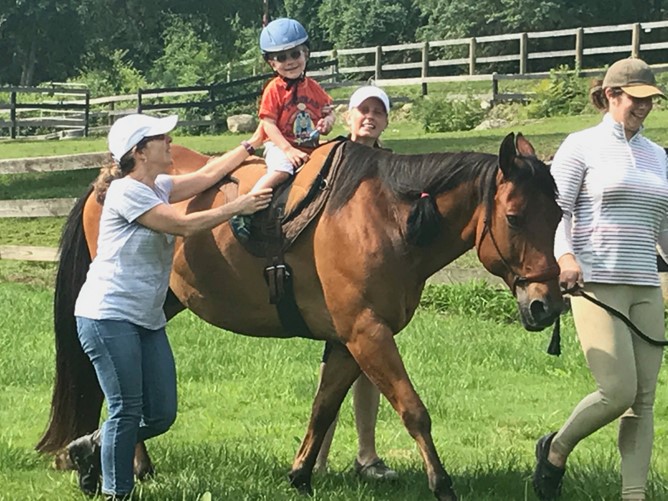Written By: Melissa Jean Jarzynski, MSPT, HPCS, ESMHL

Animal-assisted therapies and interventions have been increasingly popular over the past decade. However, hippotherapy still remains an area of mystery and confusion. But that starts to change now!
Hippotherapy is the partnership of equine movement in physical, occupational, or speech therapy sessions. The movement of the horse, when paired correctly to the movements of your client, can promote lasting functional gains.
Some gains you may see are:
– Improvements in overall strength
– Enhanced endurance
– Improved digestion & respiration
– Increased timing of protective righting reactions
Sensory:
– Improved vestibular tolerance
– Positive exposure to sensory stimulation
– Increase in self-regulation skills
Emotional:
– Decrease in Anxiety
– Improved confidence
– Improved sense of self
The difference between partnering with horses and utilizing other strategies is simple. You will be partnering your client with a living, sentient being. No other treatment strategy, to date, does this with the same profound impacts of the horse.
It may look or seem magical; however, it is simply a partnership. And this partnership of systems has been backed by years of research.
Of course, just like anything else, these greater rewards come with a greater risk. The therapist in these sessions needs to not only understand the human body systems but also that of the horse. And then pair accordingly. Because of this, it is important to remember:
- Not every horse is appropriate for every client
- Not every client is appropriate for this treatment strategy
- Not every therapist will be comfortable in this type of treatment session
If you would like to learn more, register for my upcoming Summit Live Webinar taking place on August 1st, Hippotherapy. After this course, you will be able to differentiate between the variety of ways your clients can benefit from equine movement, organize a treatment plan, and more. It will be a great time with plenty of horsing around! (Pun intended)
Visit summit-education.com for more information.
References:
Barclay,H (1980). The Role of Man in Horse Culture; 1980. J.A.Allen publishing.
Llambias, C., Magill-Evans, J, Smith, V. et al (Nov/Dec 2016) Equine-Assisted Occupational Therapy: Increasing Engagement for Children with Autism Spectrum Disorder. The American Journal of Occupational Therapy, 70 (6)1-9. DOI:10.5014/ajot.2016.020701
Guindos-Sanchez, L. D., Lucena-Anton, D., Carmona-Barrientos, I., Moral-Munoz, J. A., & Salazar, A. (2020). The Effectiveness of Hippotherapy to Recover Gross Motor Function in Children with Cerebral Palsy: A Systematic Review and Meta-Analysis. Children, 7(9), 106. https://doi.org/10.3390/children7090106
Mutoh, T., Mutoh, t., Tsubone, H., et al. (2018) Impact of serial gait analyses on long-term outcome of hippotherapy in children and adolescents with cerebral palsy. Complementary Therapies in Clinical Practice 30,19-23
Cabiddu, R, Borghi-Silva, A, Trimer, et al. (2016) Hippotherapy acute impact on heart rate variability non-linear dynamics in neurological disorders. Physiol Behav. 15,159:88-94. doi: 10.1016/j.physbeh.2016.03.012.